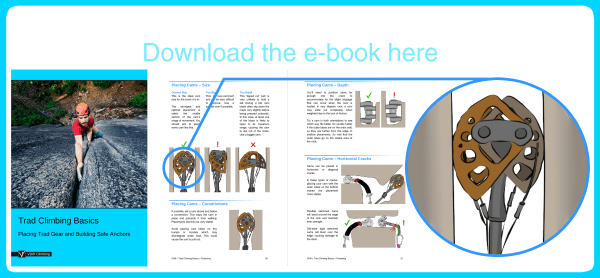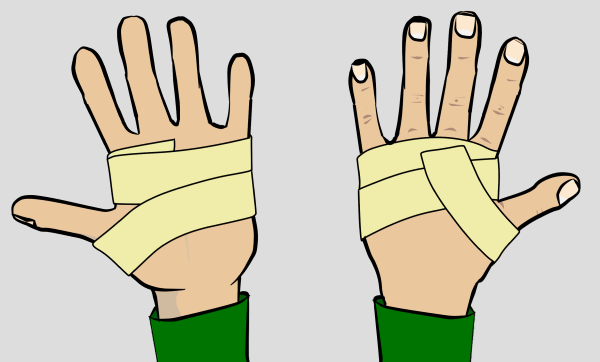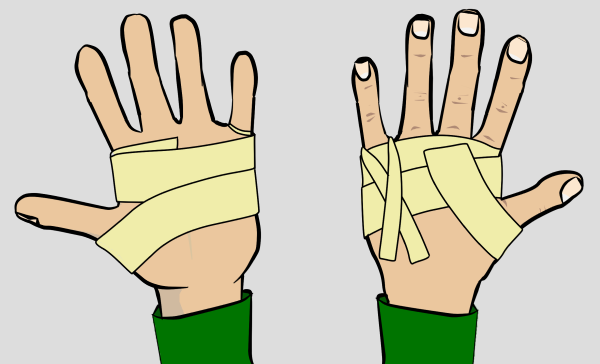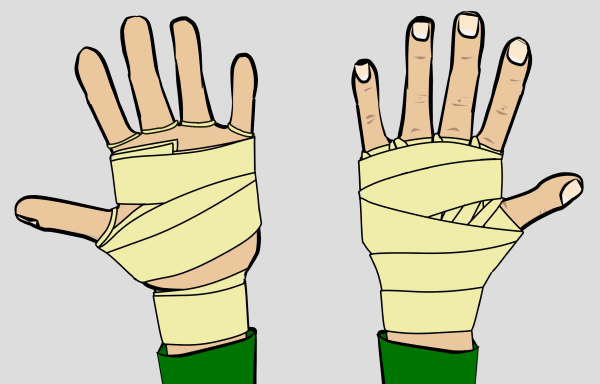'Crack Climbing Technique' is part of the book - Trad Climbing Basics.

Cracks are often very striking lines. It’s no surprise that many classic routes follow crack systems.
Some climbs have short crack sections which offer the security of a solid jam and the sanctuary of good gear. On other routes, a crack may be the only climbable feature up an otherwise blank face.
Since most trad gear is designed to work in cracks, there is usually an abundance of bomber gear on crack climbs, making them great routes for learning the art of placing trad protection.
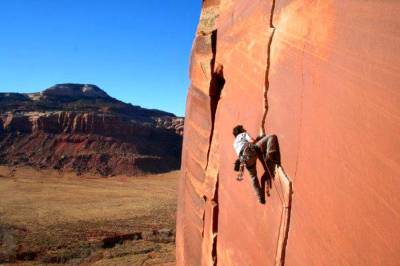
Jamming your hands and feet into cracks can be difficult (and painful) at first, but great fun once you learn the techniques.
This article covers crack climbing jams from fingertip width to full body chimneys, as well as recommended clothing.
Techniques are listed in size order, but the actual measurements of cracks are not given as this depends on how big your hands are. A climber with big hands may get a finger lock in the same place that a small-handed climber gets a perfect hand jam.
Crack Climbing: Dress for the Occasion
Clothing
For off-widths or chimneys, you’ll benefit from long sleeves and long canvas pants.
Don’t wear your best clothes though – they’ll get scraped up. Some climbers wear socks under their shoes and tuck their pant legs in to them.
How much you cover up depends on the coarseness of the rock, how long the crack is, and how good your technique is.
Shoes
Comfortable shoes which keep your toes straight are best for most crack climbing. Torquing your feet into a crack when wearing tight fitting bouldering shoes is very painful!
A high-cut shoe will save your ankle skin on wider cracks. If you have low-cut shoes, you’ll benefit from wearing socks or taping your ankles (or both) if you plan to climb anything wider than a fist crack.
For pure off-widths, you may be better with some sticky rubber approach shoes instead.
Gloves
Some climbing companies make rubber gloves for crack climbing. Made from the same sticky rubber as climbing shoes, they are designed to protect your hands from the harsh demands of crack climbing on coarse rock.
Rubber gloves are useful if you plan to do a lot of crack climbing. However, a cheaper alternative for the recreational crack climber is to make your own tape gloves using a roll of 1.5” wide athletic tape.
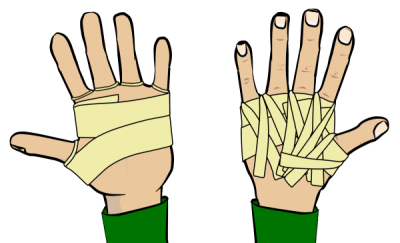
Crack Climbing > Finger Cracks
There are three techniques of climbing finger cracks:
- Finger locking
- Finger jamming
- Liebacking
When the crack is too wide for a finger jam but not wide enough for a hand jam, you’ll have to resort to more strenuous and often painful 'off-fingers' alternatives; thumb stacking and thumb camming.
Finger Locks
When there is a constriction in a crack which accepts your fingers up to the second or third knuckle, a finger lock can be very secure.
Just slot your fingers in and pull down. The further your fingers go in, the better the lock.
Try locking with your thumb either up or down for the best fit.
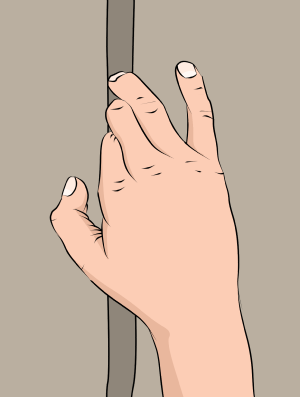
Finger Jams
If there are no constrictions for finger locks, you can use the more strenuous finger jam instead.
With the thumb down, insert all your fingers into the crack and rotate your elbow down to torque your fingers into the crack. This creates opposing pressure which jams your fingers in place.
Liebacking
If you can’t jam or lock, liebacking might get you through a few moves. Treat the crack as one long sidepull and lean from it while opposing the pressure with your feet.
This works best on corner cracks, but also works well on offset cracks (where the rock protrudes further out on one side – like a mini corner).
If the crack is more incut on one side than the other, use the more incut side for a better handhold.
If there are footholds, you may be able to switch to stemming to get a good rest. Be careful though – it’s hard to place gear when liebacking as you cannot see inside the crack.
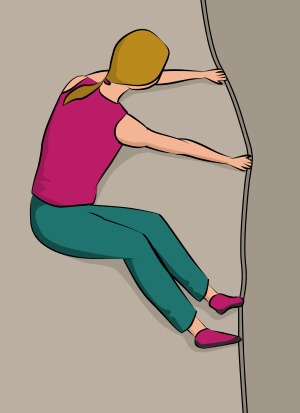
Fingertips Cracks
These cracks accept only the tips of your fingers. Super thin cracks are often difficult to protect as well as climb.
Look out for constrictions that you may be able to slot a pinky finger in and smear or edge your feet off the crack.
Sometimes you will use the crack purely for protection and climb on face holds around it.
Thumb Stacks
To thumb stack, put your thumb in the crack first, then wrap your index and middle fingers over the top. As you pull down and drop your elbow, the thumb stack torques into the crack.
To fine-tune the jam, vary the number of fingers you place over your thumb and the depth they go into the crack.
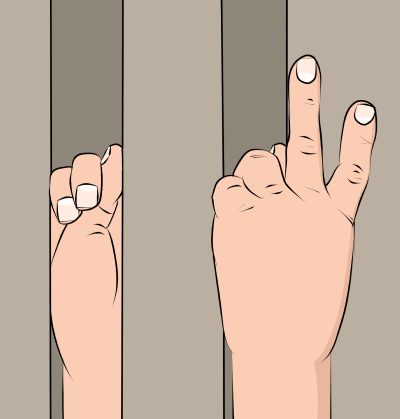
Thumb Cams
To thumb cam, put your fingers against one side of the crack with your thumb down and push your thumb against the other side.
This puts a lot of pressure on your thumb joints – be careful of dislocating it.
In corners, this only works with one hand, since the thumb is in the wrong position on the other hand.
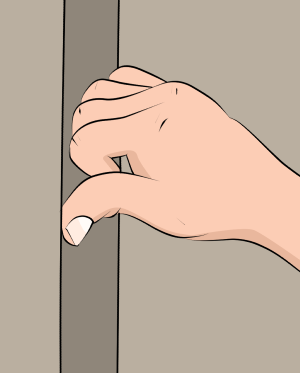
Finger Crack Footwork
Footwork is often difficult in finger and off-finger cracks because they can be too narrow to get your foot into. Often you will only be able to get the tip of your toe in.
Look out for wider spots or constrictions where you can get more purchase with your feet.
Finger Crack Sequence
The crux of many finger cracks is finding the most efficient sequence. This is mostly determined by the location of finger locks, face holds and footholds. You may need to shuffle your feet up before moving your hands, or maybe you’ll need to do a few finger locks before moving a foot up.
Constrictions make the best holds in finger cracks, but they also provide the best gear. If it is safe to do so, it can be better to use the finger lock first, then place gear in it at waist level.
It’ll make the climb much harder if you fill all the best finger locks with gear before using them.
Crack Climbing > Hand Cracks
At first, hand cracks are insecure and painful on the hands and feet. But with practise, a good hand jam is better than any jug and a foot jam is as good as standing on a ledge.
Put your hand in the crack, either thumb up or down, and fold your thumb across your palm. This expands your hand and jams it in place.
As with other types of jam, look for constrictions and slot your hand in just above to make the jam less strenuous and more secure.
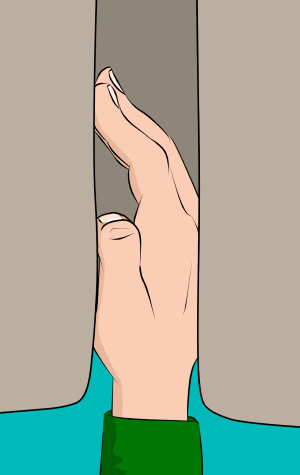
Thin Hands
For thin hand cracks, push your hand in as far as it will go and press your fingers against the crack.
Your hand is jammed in position because of the opposing pressure between your finger tips and knuckles. It’s better if you can get a thumb in to help too.
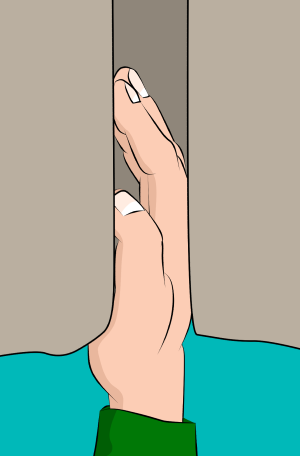
Wide Hands
For wide hand cracks, you can either cam or cup your hand.
To cam, twist a hand jam so your thumb goes further into the crack. This puts your hand in a position which is half a hand jam and half a fist jam.
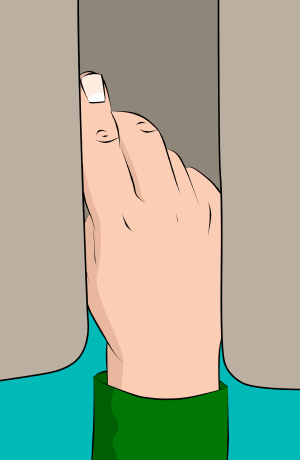
For cupped hands, make a wide hand jam and hook your thumb over your index finger if you can.
The base of your palm and fingertips press against one side of the crack, while your knuckles push against the other.
You can twist this to combine the cupped and cammed hand jam for more holding power.
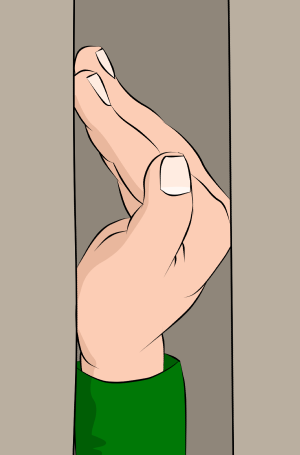
Hand Crack Footwork
To jam your feet, slip your foot halfway into the crack with the big toe up. Then torque it in by pushing your big toe down.
Hand Crack Sequence
To move fast on a straight-in hand crack, jam with your thumbs up and ‘windmill’ your arms – reach through with each jam, right over left then left over right. Walk your feet up in the same pattern.
If the crack is awkward, diagonal or in a corner, it is usually better to have a leading hand and a following hand – so you never reach through. You will generally get more reach if the leading hand is thumbs down and the following hand is thumbs up. Set a high jam, bring your lower hand up just beneath it, then move your feet up and repeat.
On diagonal cracks, you will normally keep in balance better by having one foot in the crack while the other smears on the face.
Crack Climbing > Fist Cracks
If you twist a hand jam further around it becomes a fist jam. Your thumb knuckles and outside edge of your index finger will press against one side of the crack while the outside edge of your pinky finger presses against the other side of the crack.
You can fist jam with your palms facing in or out, though facing out makes it easier to move up on straightforward fist cracks.
If the crack leans or is in a corner, try having your leading fist palm in and your lower fist palm out. As with hand jams, set a high jam, bring your lower hand up just beneath it, then move your feet up and repeat.
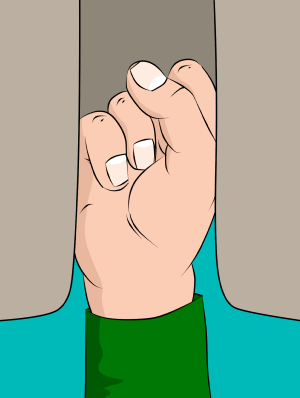
Fist Crack Footwork
Unless your feet are particularly narrow, fist cracks make great footholds. Torque them in just as you would for a hand crack.
Crack Climbing > Off-Width Cracks
Wide cracks are often regarded as more work than fun. Although they do require a lot of effort and grovelling, the challenge provides a satisfying reward. Learning the following skills takes dedication – be prepared to lose some skin in the process.
Off-Width Sequence
The general off-width sequence is:
- Get your feet wedged in the crack
- Push your upper body up and wedge it in
- Move your feet up
- Repeat
Which wedging technique you use for your feet and upper body depends on the size of the crack. Off-widths often change size so you’ll need to use a variety of techniques.
Off-Width Footwork
Foot Cam
Slide your upper foot into the crack and twist the ball of your foot against one side of the crack and your outside heel against the other.
You could then jam your lower foot on the outside of the crack by pressing the inside heel against one side and the outside front of your foot against the other.
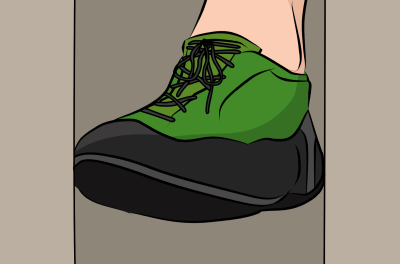
Heel-Toe Jam
If the crack is too wide for a foot cam, you can use a heel-toe jam.
Position your foot horizontally with your toe smearing on one side and your heel jammed on the other.
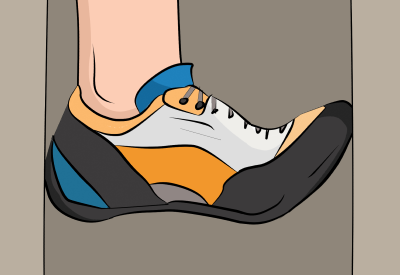
Knee Jam
This works well if the crack is slightly bigger than your knee, but be careful not to get your knee stuck.
Slide your knee high into the crack. Then pull your foot back and wrap your toes around the edge of the crack. You can do a foot cam below with your other foot.
As the crack gets slightly bigger, bury your whole thigh in the crack, then bend your knee to expand your leg in place.
Off-Width Upper Body Technique
Hand Stacks
Set two jams side by side to fill the width of the crack. You can jam hand/hand, hand/fist, or fist/fist depending on the size of the off-width.
For a hand/hand jam (butterfly stack), place the backs of your hands together and jam them in the crack with your thumbs up.
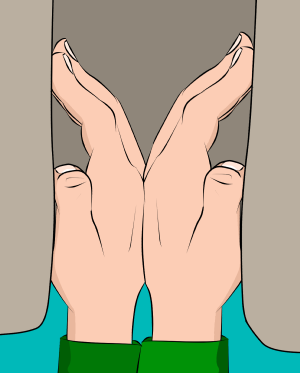
Hand/fist and fist/fist jams are generally more secure with your arms crossed at the wrist (rather than normal left/right orientation).
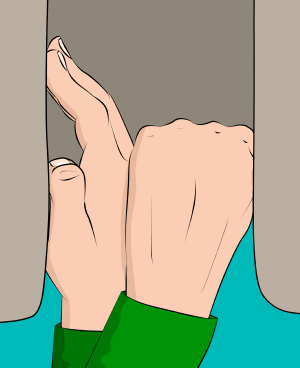
Arm-Bar
The arm-bar involves placing your inside hand deep into the crack.
Press your palm (thumbs up) against one side of the crack, and your elbow and shoulder against the other side. Use the opposing force to get a secure jam.
The other hand can gaston the outer edge of the crack. Grab it with your thumb down and elbow out, then pull away from yourself.
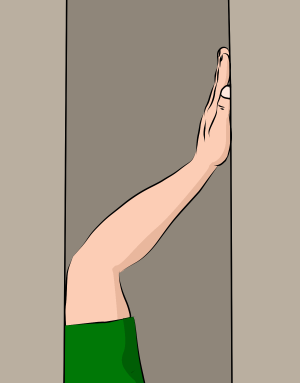
Chicken-Wing
Place your arm into the crack, elbow first, with your arm bent and palm facing out.
Push your palm against the wall and push your triceps against the other side.
Push down and outward on your chicken-wing to cam your elbow and arm into place.
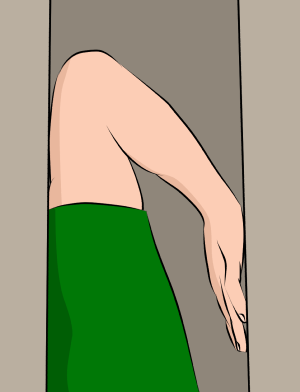
Off-Width Tips
* Once you’ve wedged yourself in a wider off-width, it can be difficult to switch sides, so plan before you get in there.
* If you don’t need to switch sides, carry all your gear (belay device, chalk, cams, everything) on the side of your harness which faces out.
* If you think you might have to switch sides, it’s much better to carry your whole rack on a gear sling. Simply swing it around to the other side to keep it out of the crack.
* Make sure you have enough wide gear (large cams and big bros) to protect the climb – many off-widths offer no other protection.
* To avoid a massive whipper, keep a cam clipped to the rope and shuffle it up as you climb. When appropriate, leave this cam behind and continue up with another clipped to the rope. Don’t forget to extend gear which is far back in the crack.
* Sometimes the crack tapers towards the back so you might be able to get a fist jam, or there may be small edges in and around the crack which make upward progress easier.
* Focus on relaxing the muscles you aren’t using to avoid unnecessary physical exertion. Rest if you find a comfortable stance, and don’t forget to breathe.
Crack Climbing > Squeeze Chimneys
Squeeze chimneys are big enough to get completely inside, but only just. One way to squirm up is to use the sidewinder technique.
To Get Set Up
- Face one of the chimney walls and turn your body diagonally so your head is only slightly higher than your feet
- Set a chicken wing with your upper arm and a reverse chicken wing with your lower arm
- Twist your upper hip forward so it opposes the pressure of your butt against the back wall
- Press your knees against the front wall and your heels against the back wall (knee bars)
To Move Up
- Pivot at the waist to move your torso up and reset the chicken wings
- Move your hips up and twist them in place
- Shuffle your feet up and reset the knee bars
- Repeat
It’s best to keep your gear hanging down on a gear sling.
Crack Climbing > Chimneys
Wider chimneys are generally easier to climb than squeezes or off-widths, but often offer no protection.
There are different methods of climbing chimneys. A standard technique is shown below.
Step 1
Set both feet against one chimney wall and oppose this with your back against the other.
Step 2
Set one foot against the back wall as high as you can.
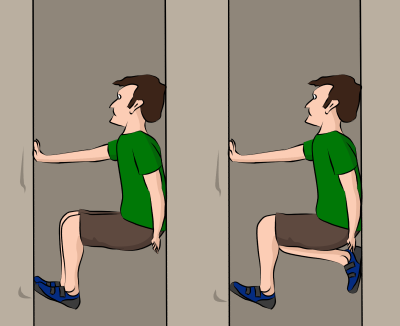
Step 3
Push up with this foot and your hands to move your body up.
Step 4
Return your foot to a higher position on the front wall and walk your other foot up to join it.
Step 5
Repeat.
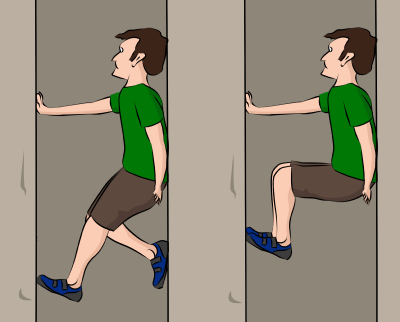
In a wider chimney, you may have to stem across it. Push off the left chimney wall with your hands to move your left foot up. Then alternate with the right side.
Bend your knees and keep your feet high to maintain a strong pressure on the chimney walls.
In a super wide chimney, a full-body stem may be required. With both hands on one chimney wall and both feet on the other, walk upwards. Make sure to keep three points of contact as you move up. Be warned – it’s hard to climb out of this position.
